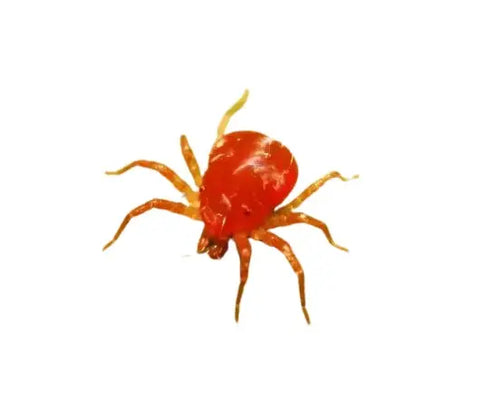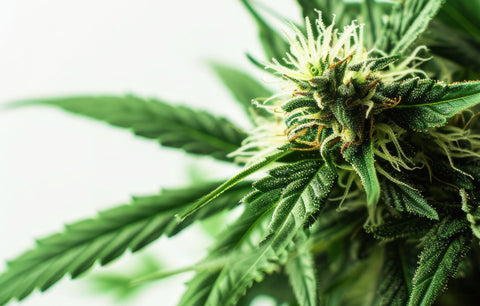
Tabla de contenidos
[HideShow]
At what temperature does the red spider die?
The red spider pest, one of the pests and diseases of marijuana , is a tiny but formidable adversary, and has earned a notorious reputation in the world of cannabis cultivation. These tiny mites, barely visible to the naked eye, are capable of wreaking havoc on plants, sucking their sap and leaving behind a trail of mottled and weakened leaves. Their presence not only undermines the health of the plants, but can also compromise the quality and yield of the crop, making them a pest feared by novice and expert growers alike.
However, as with many aspects of cannabis cultivation, knowledge and understanding can be powerful tools. In this case, understanding how temperature influences spider mite life and proliferation is crucial. Spider mites are surprisingly sensitive to temperature variations, and this is where growers can have a significant advantage. Adjusting the temperature can be an effective strategy to prevent or control an infestation. Therefore, knowing at what temperature spider mites die is essential, thus allowing growers to take preventative or corrective measures to protect their precious cannabis plants from this common and destructive pest.

What is the Red Spider?
The red spider mite, scientifically known as Tetranychus urticae, is a tiny mite that often goes unnoticed until damage to cannabis plants becomes apparent. These organisms, which are not true spiders but mites, are infamous for their ability to proliferate rapidly under favorable conditions. Typically, they range in color from red to orange, and measure less than 1 mm, making early detection a challenge.
These mites feed by piercing plant cells to suck out their contents, resulting in the characteristic mottling or yellowing of leaves. In severe cases, leaves may turn completely yellow, dry out, and fall off. A spider mite infestation not only affects the aesthetics of the plant, but can also significantly reduce its vigor, growth, and yield.
The reason cannabis plants are particularly susceptible to spider mites is due to several factors. First, the hot, low humidity conditions common in many cannabis growing environments are ideal for the rapid growth and reproduction of these mites. Furthermore, cannabis plants provide nutritious food for spider mites, allowing them to reproduce and spread rapidly if left unchecked. Early detection and effective management are essential, as an advanced infestation can be devastating and difficult to eradicate. Therefore, understanding the life cycle of spider mites and methods to control their population, particularly through temperature management, is critical to maintaining healthy and productive crops.
The Relationship Between Red Spider Mites and Temperature
Temperature plays a crucial role in the life cycle and reproduction of spider mites, directly influencing their ability to infest cannabis plants. These mites thrive in a specific temperature range, showing a significant increase in their reproduction rate and activity in warmer conditions.
In general, spider mites prefer temperatures between 20°C and 30°C, with an optimum point around 27°C. At these temperatures, their life cycle from egg to adult can be completed in just one week, allowing the population to grow exponentially in a short time. In colder conditions, their life cycle slows down considerably, and reproduction becomes less frequent. However, it is important to note that spider mites are not simply killed by low temperatures, but their activity and development are significantly inhibited.
On the other hand, extremely high temperatures, especially those above 33°C, can be lethal to spider mites. While these conditions may seem like an effective solution to eradicating the pest, they can also be detrimental to cannabis plants, making this strategy impractical in most growing scenarios. Temperature management must therefore be careful and considered, seeking a balance between discouraging spider mites and maintaining an optimal environment for healthy plant growth.

Temperature Control to Combat Red Spider Mites
Temperature control in cannabis cultivation is an effective strategy to manage and reduce the spider mite population. Adjusting the temperature of the growing environment can help create less favorable conditions for eliminating spider mites from cannabis plants , which in turn decreases their ability to reproduce and survive. Below are some temperature control strategies to consider:
- Maintaining Moderate Temperatures : Since spider mites reproduce more rapidly in warm temperatures, keeping the growing environment in a moderate range, preferably below 25°C, can help slow down their life cycle. Not only does this make it harder for them to reproduce, but it also extends the period between generations, giving growers more time to intervene and control the population.
- Using Cooling Systems : In areas or seasons where temperatures tend to be high, the use of cooling systems such as air conditioning, fans, or misters can be crucial. These systems not only help maintain a constant, optimal temperature for plants, but also create a less hospitable environment for spider mites.
- Temporarily Altering Temperatures : Some growers choose to significantly reduce the temperature during certain periods of the day, especially at night, to stress spider mites and reduce their reproductive activity. However, this tactic should be used with caution, as sudden temperature changes can also stress cannabis plants.
- Relative Humidity Control : Although not a direct control of temperature, maintaining a higher relative humidity can help, as spider mites prefer dry, warm conditions. Increasing humidity can discourage their presence, although care must be taken not to encourage other problems such as mold.
- Constant Monitoring and Adjustment : Effective temperature control requires constant monitoring and precise adjustments. Thermometers and automated systems can be a great help in maintaining ideal conditions in the growing environment.
At What Temperature Does the Red Spider Die?
The lethal temperature for spider mites is a crucial piece of information for cannabis growers in their fight against this spider pest. Studies have shown that extremely high or low temperatures can be fatal to spider mites, although the exact temperatures vary depending on various conditions and the duration of exposure.
- High Temperatures : Spider mites can begin to suffer mortality at temperatures above 33°C, especially if these conditions are maintained for prolonged periods. However, safely reaching and maintaining these temperatures in a cannabis growing environment can be challenging. Temperatures that are lethal to spider mites can also be detrimental to cannabis plants, especially if they exceed 40°C.
- Cold Temperatures : Temperatures below 0°C can be equally lethal to spider mites. However, as with extreme heat, intense cold can also damage or kill cannabis plants. Therefore, the use of extreme cold as a control method is generally impractical in a cannabis growing environment.
Tips to Reach and Maintain These Temperatures
- Careful Monitoring : Use thermometers and temperature monitoring systems to maintain precise control of the growing environment.
- Proper Ventilation : Ensure the grow area has adequate ventilation to prevent overheating, especially if high output lights or heating systems are being used.
- Using Air Conditioning : In warmer climates or during the summer, using air conditioning can help keep temperatures within a safe range for both plants and prevent spider mite proliferation.
- Thermal or Reflective Curtains : These can help moderate the temperature within the growing area, reflecting excessive heat and maintaining a cooler environment.
- Humidity Control : Increasing humidity can help lower the temperature and create a less favorable environment for spider mites.
Tools for Temperature Control in Cannabis Cultivation
To complement the treatment against red spider, it is essential to have adequate tools to control the temperature, since, as we mentioned above, temperature is key in the control of this pest. Some useful tools include:
- Thermometers and Hygrometers : To monitor the temperature and humidity of the environment, a Digital Thermo-Hygrometer is the best option to obtain both metrics comfortably.
- Heating and Cooling Systems : Such as heaters and air conditioning, to maintain the desired temperature.
- Fans and Extractors : To ensure adequate air circulation and avoid areas of excessive heat.
- Misting Systems : To increase humidity and reduce temperature when necessary.
The combined use of these tools along with chemical treatments can provide a comprehensive and effective solution for the control of red spider mites in cannabis crops.

Leave a comment